“Burst of air” replacing control surfaces on UAVs
Posted By RichC on October 23, 2010
DiscoveryNews had an article in MSNBC highlighting an unmanned aerial vehicle (UAV) call the DEMON which has fewer moving parts and uses “bursts of air” rather than traditional hinged control surfaces in order to control the aircraft. According to engineers and those working on the project, fewer moving parts will make it easier to maintain and could make it more stealthy … besides the BAE Systems images is pretty attractive too.
‘Flapless’ aircraft steered by air bursts
Plane has fewer moving parts, making it less likely to break and easier to maintain
Look Ma, no flaps! Pieces of the wing and tail that move back and forth to help control aircraft, flaps have been used to control flight since the Wright brothers — until now.
Engineers have completed a flapless flight by using bursts of air to control an unmanned aerial vehicle (UAV) they call DEMON.The research will lead to UAVs that are safer, more maneuverable and more stealthy.
“To make an aircraft fly and maneuver safely without the use of conventional control surfaces is an achievement,” said John Fielding, DEMON’s chief engineer and a professor at Cranfield University in the United
Kingdom.The eight-foot DEMON weights 200 pounds and has a maximum speed of 172 miles per hour. Seen from above, the aircraft has a distinctive diamond shape with an elongated nose, a concept known as a blended wing-body configuration.
Most aircraft manipulate their motion and direction with control surfaces found on the tailing edge of the wings and tail. When raised or lowered, air hits those flaps and the aircraft changes direction.
Instead of the traditional flaps along the tailing edge of the wings, the DEMON uses bursts of air to turn one way or another.
A flapless aircraft has fewer moving parts, making it less likely to break and easier to maintain. It could also be more stealthy, since a moving flap could show up on radar.
DEMON’s first flight took place on Sept. 17 at Walney Island in Cumbria. Engineers from BAE Systems as well as Cranfield University, Imperial College, and several other U.K. universities all worked together to complete the flight.Flapless actuators have been in development for years, said Mark Costello, a professor at Georgia Tech. The biggest benefit of these synthetic jet actuators is that they have no moving parts.
“Moving parts make it harder to maintain and repair (an aircraft),” said Costello. “A solid state device like a synthetic jet actuator means fewer things that can break.”
The DEMON won’t go into commercial production, said BAE in a statement, but the technology used in the UAV will be transferred to other aircraft.
http://www.msnbc.msn.com/id/39672627/ns/technology_and_science-science/#

Comments